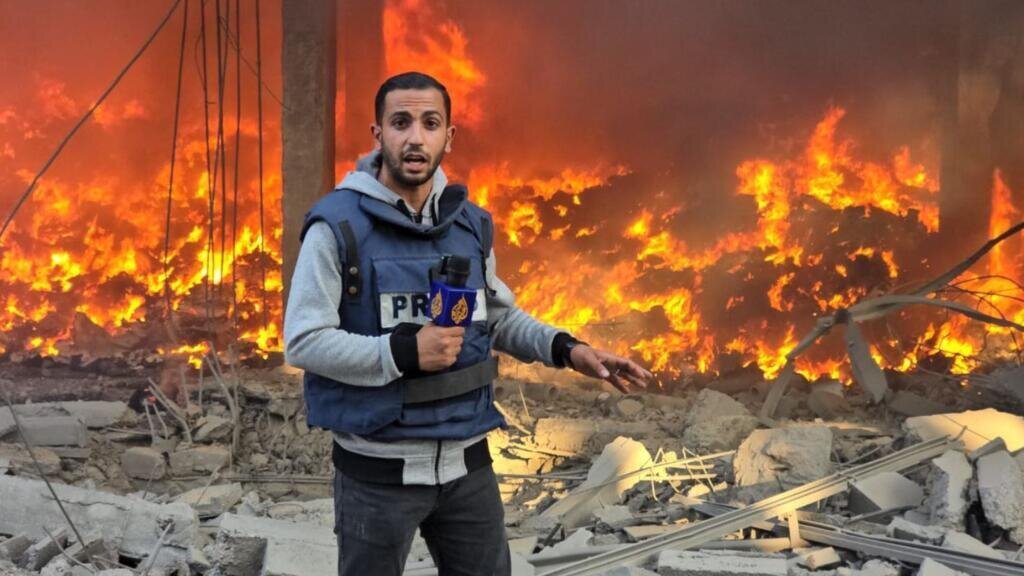The life and death of Anas Al Sharif: Gaza’s relentless voice

TEHRAN- Amidst Gaza's devastated streets, where buildings lay in ruins and daily life was stripped to its barest form, Anas Sharif more than a reporter — was a chronicler of a crisis.
At the very young age of 28, Al Jazeera correspondent Sharif lucidly and urgently documented the human face of Israel's ongoing assault. His reports transcended the simple headlines; they showed life under siege from an unfiltered perspective.
Through his very lens, the audience was faced with images not only of blasts and rubble but also of quiet calamities such as empty stares from starving children, hurried funerals in hospital courtyards, and the unyielding will of a people who refused to disappear.
In a war where truth is often the first casualty, Al Sharif, through his courage, turned journalism into an act of defiance, transforming impersonal statistics into moving human stories that argued against the indifference of the world.
Reporting from the heart of danger
The importance of Sharif derived from his unwavering presence in the middle of danger. Born in the Jabalia refugee camp, he was a child of Gaza's ongoing misfortune. He was a child of the Second Intifada, a teenager under blockade, and an adult repeatedly bombarded with war.
Reporting from northern Gaza, which is closed to foreign reporters, he compiled detailed first-hand reports that filled an important information gap. His journalism documented vast roundups of civilians, strikes on medical facilities, including Al-Shifa Hospital, and starving civilians, patterns that legal experts are starting to describe as genocidal.
As opposed to faraway satellite visions or measured official language, Sharif's live reports told the story on the ground, involving the smoke and mayhem of airstrikes, the yells of the wounded, and the fortitude of everyday Palestinians.
His voice pushed against the state narrative of Israel, witness to the claims of "precision strikes" and clear evidence of unmitigated devastation. Amidst an era of sanitized news and algorithmically-controlled experience, his work cut through the noise, ignited global outrage and solidarity, motivated aid efforts, and pressed the calls for accountability.
In certain terms, Sharif was doing more than reporting on events. He was a governing power, forcing the world to witness both the facts of the violence and the consequences of silence.
Marked as a target
Sharif’s impact also made him a priority target for Israel. On August 10, 2025, an Israeli airstrike destroyed a tent designated for journalists near Al-Shifa Hospital, killing Sharif along with four Al Jazeera colleagues—Mohammed Qreiqeh, Ibrahim Zaher, Mohamed Noufal, and another staff member. Within hours, the Israeli military claimed Sharif was leading a Hamas media unit and coordinating attacks—allegations Al Jazeera rejected as unfounded and unsupported by evidence.
This was not an isolated incident but part of a broader strategy: systematically targeting journalists to disrupt the documentation of potential war crimes. Since October 2023, more than 178 Palestinian media workers have been killed, making this the deadliest period for journalists ever recorded. Analysts note that Israel sees reporters like Sharif as direct threats because they pierce the fog of war, producing visual and firsthand evidence that could be used in international courts or lead to diplomatic fallout.
With a large audience, a history of receiving threats from Israeli forces, and coverage that exposed the realities of the siege in northern Gaza—where forced evacuations raised fears of ethnic cleansing—Sharif represented exactly the kind of scrutiny Israel sought to silence. His assassination was more than the killing of a journalist; it was an attempt to blind the global public, ensuring that what happens in Gaza can unfold without witness.
Al Jazeera has been publicly targeted by Israel’s punitive and hostile actions and cannot be allowed to work inside the country, and had its Gaza offices destroyed in 2021. It is now emblematic of a broader attack on press freedom.
Any allegations of affiliation with militants are typically used as justification, a tactic also evident in the killing of Shireen Abu Akleh in 2022.
Numerous investigations demonstrated she was outright targeted, employing the same pattern of using the absence of accountability: when accountability doesn’t exist, reporters are expendable in the information war, starving, threatening, and killing them to try to control the narrative we live in and whose history we are remembering.
A final plea to the world
Sharif’s final words, written like a will, left the world with a charge: “Do not forget Gaza… And do not forget me.” His legacy lies not in the label of martyrdom, but in the silence left behind—a stark reminder that erasing witnesses does not erase the truth.
As global powers stall and equivocate, his death underscores a clear choice: safeguard those who risk everything to expose reality, or allow history’s darkest chapters to pass unrecorded. Amid Gaza’s ruins, Sharif’s voice endures, urging the world to carry forward the stories Israel is determined to suppress.
Leave a Comment